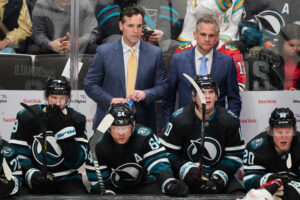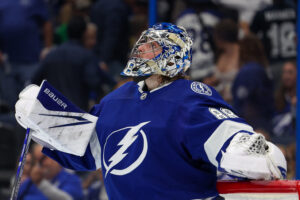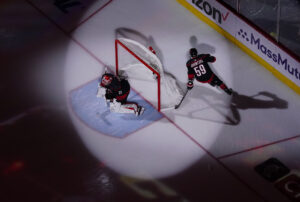With both the NHL and the NHLPA agreeing to return to the Olympic stage for the first time since 2014, team USA will have everything to prove in Beijing. The 2014 Olympics were nothing short of a dismal disaster for Team USA that concluded with a 5-0 bronze medal trouncing by tournament MVP Teemu Selanne and his pesky Fins. In order to prove they can play with consistent favorites, Canada, the Team USA hockey roster will need a complete roster overhaul that focuses on the talented young core of Americans that exists in today’s NHL.
2022 Olympics: USA Hockey Roster
The Forwards
The 2014’s USA hockey roster couldn’t stack up against Team Canada then and wouldn’t stack up against Team USA now. The increase in American-born talent available to 2022 USA GM Stan Bowman is remarkable. With 14 forward spots available, let’s take a dive into a potentially successful roster. The ages listed are the players’ ages at the time of the 2022 Beijing Olympics, February 4th- February 20th, 2022. For further explanation on advanced stats referenced, see LWOS’ Oscar Elieff’s introduction.
Centers
Top Six
Auston Matthews C (24): Not much needed to defend this. Matthews is well on his way to winning his first Maurice “Rocket” Richard Trophy. He leads the NHL in goals this year while being one of the best drivers of offense and best goal scorers per 60 minutes of play.
Jack Eichel, C (25): Injuries ruined his 2020-21 season before it could really start, but when healthy, Eichel is indisputably one of the league’s best players. Eichel is an excellent two-way threat who drives play, scores goals (in previous years), gets primary assists, and has rounded out his defensive game.
Bottom Six
Dylan Larkin, C (25): Though he had a down 2020-21 season, Larkin was not the sole reason for the Detroit Red Wings second-last ranked offense. Larkin faced the most defensive zone starts of his career yet was still able to stay afloat in terms of his relative Corsi and Fenwick percentages. The underlying metrics suggest Larkin is far to closer to the player two seasons removed from 73 points in 76 games.
Jack Hughes, C (20): Before you scoff at Hughes’ somewhat modest point production, take a closer look at what he’s doing on a young squad. In only his second season, Hughes is centering rookies Yegor Sharangovich and Janne Kuokkanen to being a top twenty NHL line in terms of expected goal percentage. The Devils consistently control play with Hughes on the ice and his only knack remains his lack of goal scoring. Hughes could really tap into his scoring potential with elite talent on his wings.
Vincent Trocheck, C (28): It’s befuddling the Florida Panthers hat gave up on Trocheck in his prime. Then again, this is the same Florida who gave up Reilly Smith and Jonathan Marchessault in an expansion draft too. Nevertheless, Trocheck is having an excellent, rejuvenated season. He is driving play and back to scoring at a 30 goal pace over a full season.
Wingers
Top Six
Patrick Kane, RW (33): At 32 he remains a dynamic, top 10 points-per-game player. In the past five seasons, only Connor McDavid, Leon Draisaitl, and Brad Marchand have scored more points than Kane. It doesn’t hurt that he is still one of the most exciting players to watch.
Jake Guentzel, LW (27): Guentzel is quietly one of the best wingers in the NHL. He is sixth in the NHL in expected goals this season and is ninth in even-strength goals over the past three seasons. He has taken his humble beginnings as a third-round pick to becoming a high percentage shooter (career average 16.3%).
Johnny Gaudreau, LW (28): Gaudreau is still Johnny Hockey. Over the past 3 seasons, Kane and Matthews are the only Americans with more points than Gaudreau. Gaudreau’s positive metrics show he still carries play in the right direction. His speed is also an asset that will be very useful at the Olympic level.
Alex DeBrincat, LW/RW (24): After a disappointing 2019-20 season, DeBrincat is having a monstrous offensive season opposite Kane’s wing. DeBrincat is a top-five goal scorer this year and a top fifteen goal scorer over the past three seasons. His Corsi For and Fenwick For percentages aren’t astounding, but they are positive relative to his team and his team scores more goals than they let in with him on the ice.
Bottom Six
Matthew Tkachuk, LW (24): Apart from being a pain to play against, the elder Tkachuk is a puck possession monster who has helped his team control play each of his five seasons. He is only two seasons removed from putting up 77 points in 80 games and his lack of production this year can be partly attributed to a career-low shooting percentage (7.8%).
Brock Boeser, RW (24): Boeser started off this season hot and very much in the Rocket race, but things tapered off with him on pace for just under 30 goals over a full season. Brock is an excellent finisher with a beauty of a shot, who also has good playmaking skills. His possession metrics were down from last year, but still positive relative to his team’s performance.
Max Pacioretty, LW (33): Patches tuned out all the trade chatter this offseason and responded with more than a point per game production. Over the last three seasons, he is 16th in the entire league in even-strength goal scoring. He consistently is a positive possession player and is still elite at 32.
Jason Robertson, LW (22): A Calder finalist, Robertson drives play, draws penalties, and is statistically one of the best finishers in the league. Robertson has as many primary assists as Crosby and notably more than guys like John Tavares and Mark Scheifele. Hopefully, GM Bowman doesn’t overlook Robertson in favor of a not as good veteran like Blake Wheeler.
Extra
Brady Tkachuk, LW (22): Equally a pain to play against, Brady gets this final spot over Kyle Connor due to his ability to generate offense at an elite level for those around him. Brady creates a ton of rebounds, has the fourth-highest individual expected goals, and draws more penalties than anyone in the league. The most glaring dichotomy between Brady and Connor is Connor’s superior finishing ability. The main issue with Connor is that despite his goal-scoring, his team usually is dominated in terms of expected goals against, giving up more high-quality chances than they generate. Giving up more high-quality chances than generated will not match up well with Canada. This group has more than enough proven finishers to offset Brady’s low shooting percentage and Connor’s exclusion.
Defense
2014’s defensive unit had a pretty clear mix of defensive defenseman and puck movers. If 2022’s unit is indicative of anything, it demonstrates the trend of the NHL towards more complete defenseman who can play both sides of the rink.
Top Four
Adam Fox, RD (23/24): While Canada will have the undisputed best forward in the world, the US will have the best defenseman in the world this year. With Adam Fox on the ice, the Rangers have an expected goals for of 59.2% compared to 43.1% without him. If fancy stats aren’t your thing, how about Fox as the top-scoring defenseman with 47 points in 55 games?
Charlie McAvoy, RD (24): Although the production isn’t quite there the way it is for Fox, Charlie is every bit the two-way defender Fox is. Charlie is better than 99% of the league at driving offense, 98% at even strength defense, 99% at penalty killing, gets more primary assists per 60 than 93%, and more points per 60 than 91%.
Jakob Chychrun, LD (23): Chychrun the goal scoring phenom? Chychrun always had the pedigree, but this season he finished second on the Coyotes in goals, scoring at a 30 goal pace over a full season. He might not be as sound defensively as Fox or McAvoy yet, but the metrics look good. The Coyotes had 53.4% of expected goals with Chychrun on the ice that plummeted to 41.7% without him.
Jaccob Slavin, LD (27): Despite his somewhat down year offensively, Slavin remains a very good play driver who generates great results in his CF%, FF%, GF%, and xGF%. His increase in defensive zone starts for Carolina this year could explain some of his defensive regression. He will no doubt be a top option for the USA Hockey roster though.
Bottom Four
Matt Grzelcyk, LD (28): Grzelcyk’s familiarity and success with McAvoy on Boston’s top pairing is unmistakable. The metrics on the Grzelcyk – McAvoy pairing show that they are one of the leagues’ best pairings. They have the highest CF%, FF%, GF%, and xGF% in the league for pairings that have spent at least 200 minutes together.
John Carlson, RD (32): Into his 30s, Carlson has remained one of the best offensive defensemen in the world. Putting up a point per game numbers last year, and was no slouch this year. Over the past three seasons, no other defenseman has more even-strength points than Carlson. Ideally, he would be on the third pairing, paired with someone more defensively adept, as his defensive game is mainly inept.
Brett Pesce, RD (27): Pesce is quietly a terrific play-driving defenseman who is excelling while facing the highest defensive zone start percentage of his career. It doesn’t hurt that he’s averaging 37 points over a full season. If Pesce needs to step in, he could provide more defensive stability than Carlson while still keeping the play moving in the right direction.
Jake McCabe, LD (28): Yep. McCabe is both your dad’s defensive defenseman of yore and the nerd’s defensive defenseman of now. McCabe does a better job of suppressing opposing offense and limiting chances than 97 percent of the NHL. He has truly come into his own and could form a formidable shutdown pairing or let Carlson fly on the third pairing. He may be a longshot, but by the numbers, there is an argument to be on the roster.
Goalies
2022’s group features a complete overhaul of the old guard of Jimmy Howard, Jonathan Quick, and Ryan Miller. If the USA can get anything close to the performance they got from the 2010 Olympic MVP Miller, they will be in excellent shape.
Connor Hellebuyck (28): Hellebuyck has been an absolute workhorse for the Jets for five seasons now. Though his save percentage may not appear incredible, this can be attributed to his team’s defense that allows the third most high danger chances against. A more defined measure of Hellebuyck’s impact can be seen in his goals saved above expected where he ranks second to only Andrei Vasilevskiy.
John Gibson (28): A talented goalie behind a bad team, Gibson had a Vezina start to 2021 that couldn’t be sustained on the rebuilding Ducks. Though Gibson’s save percentage and goals saved above expected dropped off, he has a large enough sample size of success with 5 seasons at or above a .914 save percentage.
Thatcher Demko (26): This comes down to Demko and Alex Nedeljkovic. Nedeljkovic has the superior save percentage and goals saved above expected in 2021 but also has the first-place team ahead of him. Demko meanwhile also finds himself in the top ten for goals saved above expected with a respectable save percentage considering the Canucks’ Covid crisis and poor defense. At this time, Demko gets the edge due to his ability to succeed on the Canucks this year. However, postseason heroics from Nedeljkovic could get him past Demko.
Lines
Guentzel – Matthews – Kane
Gaudreau – Eichel – DeBrincat
M. Tkachuk – Larkin – Boeser
Pacioretty – Hughes – Robertson
Chychrun – Fox
Grzelcyk – McAvoy
McCabe – Carlson
Hellebuyck, Gibson
Extras: B. Tkachuk, Trocheck, Slavin, Pesce, Demko
*Advanced Stats From: Jfresh x Top-Down Hockey, Natural Stat Trick, Money Puck, Evolving Hockey
Main Photo:






